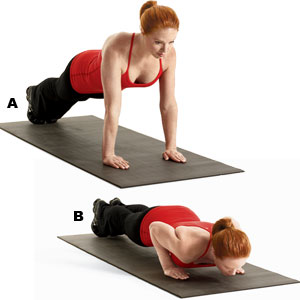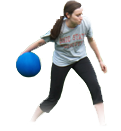
What the Number of Pushups You Can Do Says About Your Heart Health
New research suggests men who can do 40 pushups or more at once may have lower risk of heart disease than those who can’t. Here’s why.
Was the last time you did pushups in gym class?
If so, it could be time to lie down and try out a few reps, because this simple exercise means more about your health than you think.
According to a new study published in JAMA Network Open, pushup capacity is inversely associated with future cardiovascular disease (CVD) incidents — meaning the more pushups you can do, the less likely you are to have a heart attack or stroke.
Researchers found that CVD risk was 96 percent lower in men who were able to do 40 or more pushups during a physical test compared to men who could do 10 or fewer.
The retrospective longitudinal study followed 1,104 male firefighters over a 10-year period between 2000 and 2010. The men underwent baseline and periodic physical examinations that included timed pushups and cardiorespiratory endurance (such as a treadmill test).
“Those completing the least pushups at baseline went on to have the highest rates of new CVD diagnoses; while those competing the most pushups at baseline enjoyed the lowest subsequent rates of CVD,” Dr. Stefanos N. Kales, MPH, professor of medicine, Harvard Medical School, and one of the study’s authors, told Healthline.
Surprisingly, he said, pushup capacity also was a better predictor of CVD outcomes than submaximal treadmill tests, a more commonly used test.
How these findings can help improve your health
The study suggests several practical takeaways both in the healthcare setting and beyond.
First, a pushup test is simple and quick to perform. The men in the study were required to simply perform pushups set to a metronome beat until they hit 80 push ups, missed three metronome beats, or stopped because of exhaustion.
So, if the test is an accurate predictor of CVD outcomes, it would be a cheap and easy way for doctors to assess a patient’s health — providing a “snapshot” of sorts.
It could also be an easy way for an individual to get a sense of their own health and CVD risk.
Doctors tend to rely more heavily on measurements (think weight, height, and BMI) and serum biomarkers, such as blood lipids and cholesterol when assessing cardiovascular health.
Cardiorespiratory fitness (CRF) tests, which are actual dynamic physical tests of the human body, like a treadmill test, “have largely been neglected by clinicians,” wrote the authors.
In 2016, the American Heart Association released a scientific statement concluding that “CRF should be measured in clinical practice… Indeed, decades of research have produced unequivocal evidence that CRF provides independent and additive morbidity and mortality data that when added to traditional risk factors significantly improves CVD risk prediction.”
The problem with typical CRF testing is that it’s typically expensive, time-consuming, and requires special personnel. Kales argues that pushup capacity solves these problems: It can be done in a doctor’s office at no cost, takes only a few minutes, and doesn’t require additional personnel.
One exercise does not fit all
However, there are still some caveats regarding the study’s conclusions.
“This study cannot be applied to the general population who would find it difficult to do pushups,” said Dr. Guy L. Mintz, director of Cardiovascular Health & Lipidology, Northwell Health’s Sandra Atlas Bass Heart Hospital, Manhasset, New York.
“I feel that this study represents a niche group of patients (male firefighters) for a niche test. There are many patients including women that cannot do pushups, for example, lack the arm strength, but can do a significant amount of cardiovascular exercise and are physically fit,” said Mintz, who is unaffiliated with the research.
Indeed, and that is something that the study authors admit: Whether their conclusions using firemen — a population that is already likely in better physical shape than the general population — can be extrapolated onto the general population would require more research.
Those with physical disabilities, injuries, or lacking upper-body and arm strength could also find it difficult to perform the test.
For the average population, says Mintz, goals such as improving aerobic capacity and modifying traditional risk factors (such as diet) could prove more beneficial than focusing on pushups.
“I don’t recommend that sedentary people who are unaccustomed to pushups or who have not done them for a long time should test themselves. It is always prudent to consult your physician before beginning a new exercise program,” said Kales.
“Additionally, based on a person’s health, strength, conditioning, and previous training history, an athletic trainer may recommend different starting points — walking instead of running or biking; light weights or assisted body-weight exercise, rather than going directly to body-weight exercises like pullups and pushups,” he said.
Both agree that pushup-capacity testing could serve as a valuable way to instruct or integrate health initiatives in the workplace — a goal of both physicians and the American Heart Association.
Because the workplace has many of the same limitations for fitness testing as a doctor’s office, in addition to lacking traditional assessment tools, pushups could be performed as a simple test for CVD outcomes in some cases.
“Exercise in the workplace is a great idea and should be a public health mandate,” said Mintz.
The bottom line
A new study, published in JAMA Network Open followed 1,104 male firefighters over a 10-year period between 2000 and 2010.
Researchers found that the risk of cardiovascular disease incidents were 96 percent lower in the men they tested who were able to do 40 or more pushups during a physical test compared to men who could do 10 or fewer.
While experts agree pushup-capacity testing could serve as a valuable way to instruct or integrate health initiatives for some people, it’s not an accurate predictor that can be applied across the board.
For the average population, goals such as improving aerobic capacity and modifying traditional risk factors (such as diet) could prove more beneficial than focusing solely on the ability to do pushups.
The Arena District Athletic Club is more than just a gym, it’s a premier fitness facility located in the heart of the Arena District in downtown Columbus. We provide convenience and quality, featuring top-of-the-line equipment, top-notch personal trainers, spa-like locker rooms and a wide variety of free group fitness classes daily including Cardio, Spinning, Barre Fusion, Yoga, Boot Camp and more. We offer free 2-hour parking and convenient contract-free memberships, to fit your healthy lifestyle needs. Don’t just join, belong.





